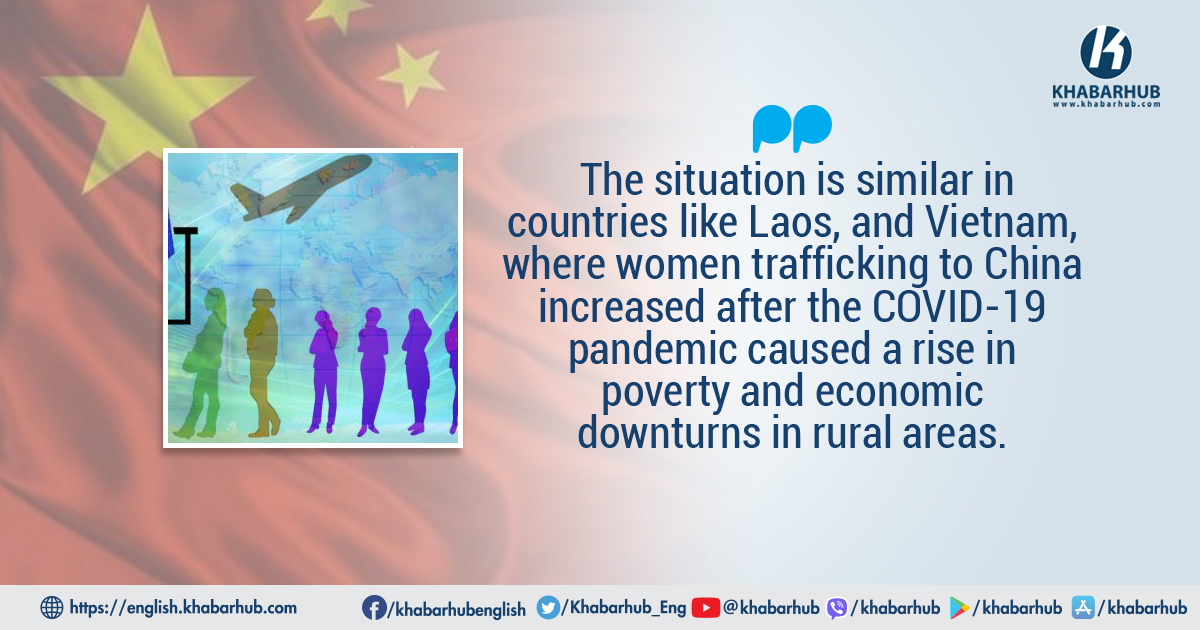The demographic crisis in China has had its negative effects spill over to neighbouring countries as poor young women from South Asia and South East Asia are being smuggled for marriage to Chinese men.
The shortage of brides in China due to the gender imbalance caused by the now-abolished one-child policy has fuelled women trafficking from countries like Pakistan, Myanmar, Nepal, Cambodia, Indonesia, Laos, North Korea, and Vietnam.
Human Rights Watch (HRW) said it gathered “compelling evidence” about how these countries became the source of women trafficking to China.
“Coupled with China’s traditional preference for boys, the one-child policy created an estimated 30 to 40 million ‘missing women’ and fuelled a demand for trafficked women and girls, spurring a business in selling humans in countries across Asia and within China,” it said.
Once trafficked into China, these poor Asian women are sold to Chinese families for around USD3,000 to USD13,000.
Pakistan is a major source of bride trafficking to China.
Poor young women from Christian or even Muslim communities are victims of trafficking to China, said Madiha Afzal, a research fellow at Brookins Institution.
“The victims were lured with payments to the family and promises of a good life in China, but reported abuse, difficult living conditions, forced pregnancy, or forced prostitution once they reached China,” she said.
The traffickers used legal ways to take Nepali women to China on false pretexts, and then exploit them, said Anjana Shakya, chairperson of the Alliance Against Trafficking of Women and Children.
Afzal highlighted the fact that women trafficking occurred around the China-Pakistan Economic Corridor (CPEC), a part of the Belt Road Initiative (BRI).
The 2023 report on trafficking in Pakistan by the US Department of State too expressed concerns over the exploitation of impoverished Christian communities in Pakistan by Chinese traffickers.
“Upon arrival in China, hundreds of Pakistani women reported their ‘husbands’ forced them into commercial sex. Chinese nationals employed in Pakistan at worksites affiliated with the Belt and Road Initiative are vulnerable to forced labour,” reads the report.
While officials in China and Pakistan said they made efforts to stop the women trafficking, the ground realities show poor women are still being smuggled to China.
A Pakistani official admitted that the women trafficking racket was growing due to a lack of efforts to protect the poor girls.
“The authorities won’t follow through, everyone is being pressured to not investigate. Trafficking is increasing now,” said the official on condition of anonymity.
The women trafficking to China is likely to increase in the future as the gender imbalance is going to leave about 25 percent of Chinese men unmarried by 2030, feared HRW.
In 2021, the number of males for every 1000 females in China increased to 112.
The gender imbalance led to a sharp increase in the demand for women from the neighboring countries.
Geneva-based child rights organization Humanium brought to the fore how trafficked women are subjected to mistreatment as Chinese men are more interested in having a baby with a wife rather than marriage.
“There is a strong overlap between trafficking for the purpose of marriage and sexual exploitation, placing women at risk of rape, among other heinous abuses,” it said.
The situation is similar in countries like Laos, Vietnam, where women trafficking to China increased after the COVID-19 pandemic caused a rise in poverty and economic downturns in the rural areas.
Nepal, which is one of the recipients of BRI funding, has reported cases of women trafficking to China.
Nepal police arrested a few Chinese nationals involved in trafficking activities in the recent past.
The traffickers used legal ways to take Nepali women to China on false pretexts, and then exploit them, said Anjana Shakya, chairperson of the Alliance Against Trafficking of Women and Children.
“Although Chinese nationals take Nepali women by following all legal processes, these women are at high risk of being used as sex slaves or unpaid labourers,” she said.
Investigative Journalism Reportika has prepared a comprehensive report on the trafficking of Asian women to China and their exploitation.
It said advertisements for ‘brides’ and ‘surrogate mothers’ wanted for Chinese men in exchange for payment could be seen posted on walls and lampposts in Myanmar.
The situation is similar in countries like Laos, Vietnam, where women trafficking to China increased after the COVID-19 pandemic caused a rise in poverty and economic downturns in the rural areas.
The Laos government identified 448 women who became victims of trafficking in 2022.








Comment